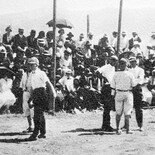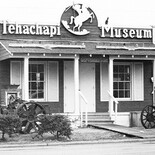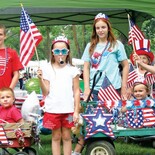The history of 4th of July in Tehachapi
Land of Four Seasons
June 25, 2022
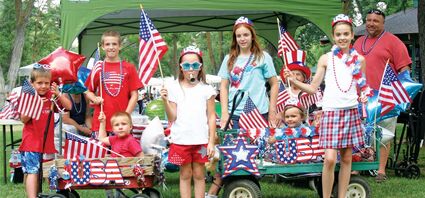
Jon Hammond
A Tehachapi family going all out for the All-American 4th of July Festival at Philip Marx Central Park.
Our Fourth of July celebrations are a uniquely American tradition, commemorating the issuing of the Declaration of Independence in 1776. This transformative document, announcing to the world that the American colonies had officially broken free of England, changed the course of human history, and its signing has been marked by festivities ever since.
While the Declaration of Independence is dated July 4, 1776, it was voted on and approved by congress on July 2, so some people, including John Adams, felt strongly that July 2 should be the official Independence Day. That didn't take hold, however, and Americans all over the country (and even the world) continue to celebrate on the Fourth of July.
Independence Day has been marked in the Tehachapi Mountains since the arrival of the first American settlers in 1856. In those earlier times, Christmas and the 4th of July were probably the two most universally celebrated holidays in America.
Fireworks are now an integral part of Independence Day celebrations and Tehachapi is well-known for its great community firework display, but even long before the pyrotechnics arrived, the Fourth of July was a noisy event, marked by gunfire and even cannon shots by those towns that had a cannon in their possession.
In Tehachapi, those celebrating sometimes engaged in a dangerous practice called "anvil firing" or "anvil shooting." In this case, an anvil serves as a stand-in for a cannon, and the concave hollow typically found on the underside of an anvil is packed with a pound of black powder and ignited by a fuse, often with one anvil, the flier, placed on top of another anvil that is upside down.
When the black powder explodes, the upper anvil flies 100 feet or higher into the air, and then plummets back down Earth. If you're thinking this sounds like potentially risky activity, congratulations – you can recognize a threat when you see one. I have an antique anvil that reportedly came from one of John Moore Brite's old sawmills, and it is broken in half, with the upper section completely separated from the missing base. I was told that it was a victim of a 4th of July anvil firing.
Another early Tehachapi tradition was the annual Independence Day baseball game, which was usually played in the vicinity of what is now Tehachapi Airport. Nearly the whole town and the scattered residents from the outlying areas would converge for a baseball game against a team from a neighboring community, often Mojave. In the late 1800s and early 1900s, Tehachapi and Mojave were similar in population, and were often heated rivals. There are old black and white photos from the Wiggins family of those festive baseball games of 100 years ago, with people and cars and red, white and blue banners all packed together in a festive, jubilant celebration.
People in those earlier times used to work, and often work hard, six days a week. The Fourth of July was a national holiday, regardless of what day of the week it happened to fall on, so in addition to the patriotic aspects of the occasion, hard-working Americans were grateful to simply have a day off.
The Fourth of July in Tehachapi has changed over the years, as different aspects were added or dropped, but it definitely remains a festive day. In addition to the longstanding firework display that begins promptly at 9 p.m. over near the rodeo grounds and Tehachapi Airport, there have been parades, bull riding, hot dog festivals, art and craft shows, hot air balloons in Bear Valley, egg toss in City Park and more.
Nearly 50 years ago there was another significant element added when the Tehachapi Heritage League was launched and the Tehachapi Museum officially opened on July 4, 1973. Originally it was located in an old land office building that had been moved to the Railroad Park. This small structure later housed the Greater Tehachapi Chamber of Commerce, and was eventually replaced by the newer Chamber building that is there now.
The Tehachapi Museum moved to its present location on South Green Street in the old Tehachapi Library building, and was eventually joined by its sister across the street, the Errea House Museum.
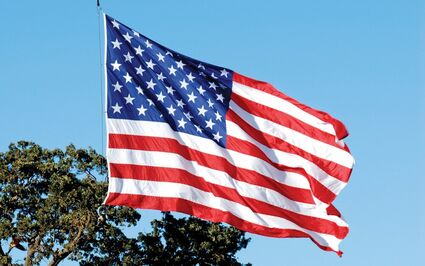
Jon Hammond
The American flag flies in Golden Hills near Meadowbrook Park thanks to a crane provided by RST Cranes.
Each year the Heritage League celebrates its birthday on the Fourth of July, and gives out birthday cake to visitors.
However you choose to enjoy the Fourth of July this year, remember those from the past whose hard work and sacrifices have made it possible.
Keep enjoying the beauty of life in the Tehachapi Mountains.
Jon Hammond is a fourth generation Kern County resident who has photographed and written about the Tehachapi Mountains for 38 years. He lives on a farm his family started in 1921, and is a speaker of Nuwä, the Tehachapi Indian language. He can be reached at tehachapimtnlover@gmail.com.



